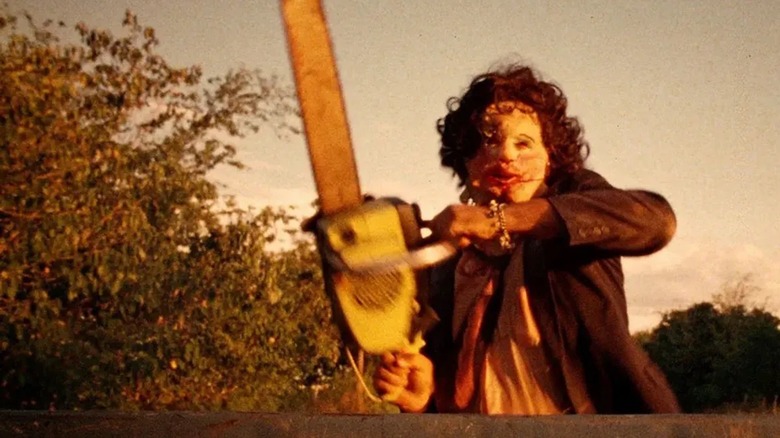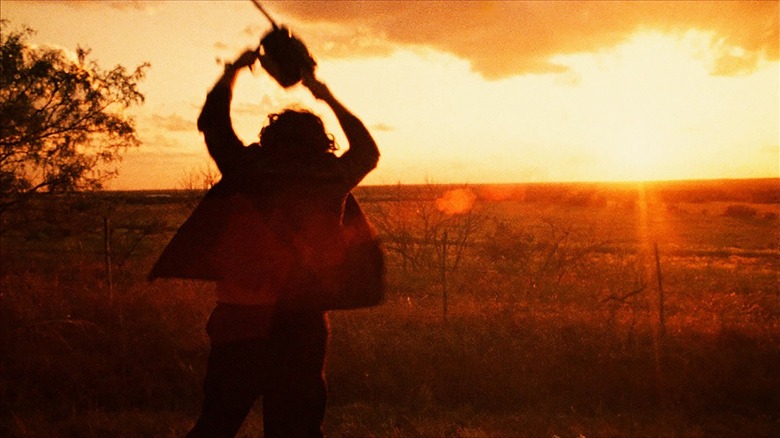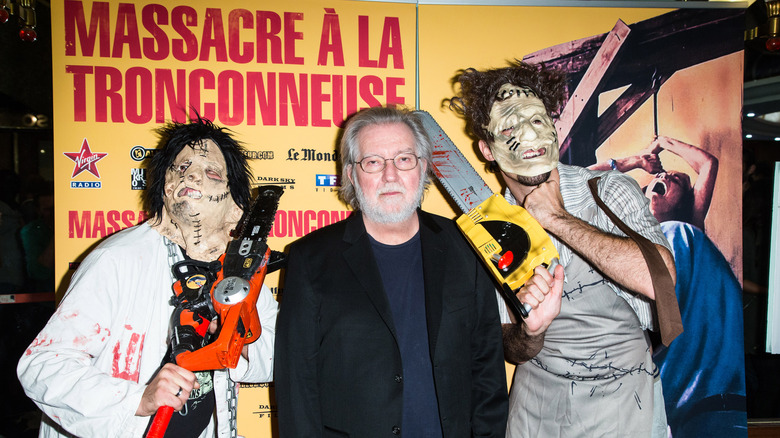Tobe Hooper Believed Hollywood Had 'Let Down' Its Most Important Horror Directors
Hollywood didn't force Tobe Hooper to make horror movies, but he and other top genre directors may have felt a little trapped in genre jail by the Hollywood brass. Tobe Hooper began his career as more of a surrealist filmmaker with the hallucinatory hippie romance "Eggshells" back in 1969. Hooper shot the film in Austin, Texas where, at that time, the capitol city was becoming a haven for the blossoming counter culture movement, even if local law enforcement and conservative Texans weren't exactly welcoming them with open arms. Hooper's inventiveness and prowess behind the camera was already apparent in "Eggshells," especially in the more psychedelic sequences that used a lot of camera tricks and compositing to make it feel like the viewer was going through the same psychotropic journey as the hippie couple up on screen.
There were already echoes of Hooper's next film, "The Texas Chain Saw Massacre," in the setup for "Eggshells," which follows a group of free-loving students who move into a large, old abandoned house in the woods. From there, some kind of external force begins to influence them in strange ways. That premise wouldn't take much tweaking on Hooper's part to become a set-up for a horror film. The production of "Eggshells" was also where Hooper met and befriended Kim Henkel, the writer of "The Texas Chain Saw Massacre."
"Eggshells" didn't get enough attention, so Hooper turned to low-budget horror to tell a story about what happens when the hippies leave city life to head out to the supposedly idyllic countryside. It was Hooper's decision to become a horror director, a choice that would later wind up trapping him in a Hollywood system that never gave him and other masters of the genre a chance to branch out.
No one puts Hooper in a corner
Looking back at the late '60s and early '70s, there was a sizable dearth of visceral horror until "Rosemary's Baby" and George Romero's "Night of the Living Dead" changed everything. Unknowingly, Romero became the first member of a horror collective that would later include Hooper, Wes Craven ("Last House on the Left"), John Carpenter ("Halloween"), and David Cronenberg ("Shivers," "Rabid"). They would go on to re-invent the genre, pulling away from the age of monsters into the age of slashers and transgressive cinema. They would also all eventually voice their frustration at being pigeon-holed as artists.
Hooper and his ilk are horror legends now, but they all came to realize they were being stifled creatively. In a past interview with The Flashback Files back in 2015, Hooper spoke about his peers and his frustrations with the studio system:
"Not only do they understand the genre, they understand how the Hollywood establishment perceives us. And the way the industry has let us down.They keep us in a corner. That's only in the United States. In Europe it's different. Cinema is viewed differently here. In the States they are making films to sell toys. It really is all about money."
In a moment of great insight, Hooper also astutely observed that the big budget Hollywood machine was beginning to influence and infiltrate the genre world:
"They depersonalize the movies. And as a result they try to second-guess the audience. An ugliness is springing up in the genre branch of cinema, in all branches of cinema. These executives are so afraid that someone won't understand something, that films have taken a turn in explaining themselves, leaving the audience nothing to do but to sit there and observe."
A legacy of legends who respect the audience
Hooper knew that there were people like him out there that wanted to see something graphic on screen that also felt true to life. The war in Vietnam had caused audiences to grow accustomed to seeing graphic depictions of violence in a documentary-style form. His vision of "The Texas Chain Saw Massacre" came at the perfect time, even if it's not as gory as everyone remembers. Almost two years before he passed away in 2017, Hooper spoke about his need to bring something new to the genre, explaining "I really was trying to make a film that I wanted to see and hadn't seen before. My sensibilities had been finely attuned to what I wanted to see as an audience member. Even the great Hammer movies, on which I grew up and which I loved, they had gone away." The timing was perfect for films like "Living Dead" and "Chain Saw" to make a real cultural impact and leave the British sensibility of Gothic horror behind.
Somehow, Roman Polanksi never became labeled solely as a horror director after the incredible success of "Rosemary's Baby." Polanski had made "Repulsion" and "The Fearless Vampire Killers" leading up to his demonic smash hit. The massive box office probably put him in another stratosphere that catapulted him beyond just being considered a new master of horror. Tobe Hooper, Wes Craven, George Romero and David Cronenberg went on to make beloved horror classics that rarely ever catered to Hollywood and always tried to respect the intellect of genre fans. That's more than enough to cement a legacy. However, Hooper may have felt a little jealousy toward Polanski (vie Flashback Files): "I would have liked to end up doing something like "Chinatown."


